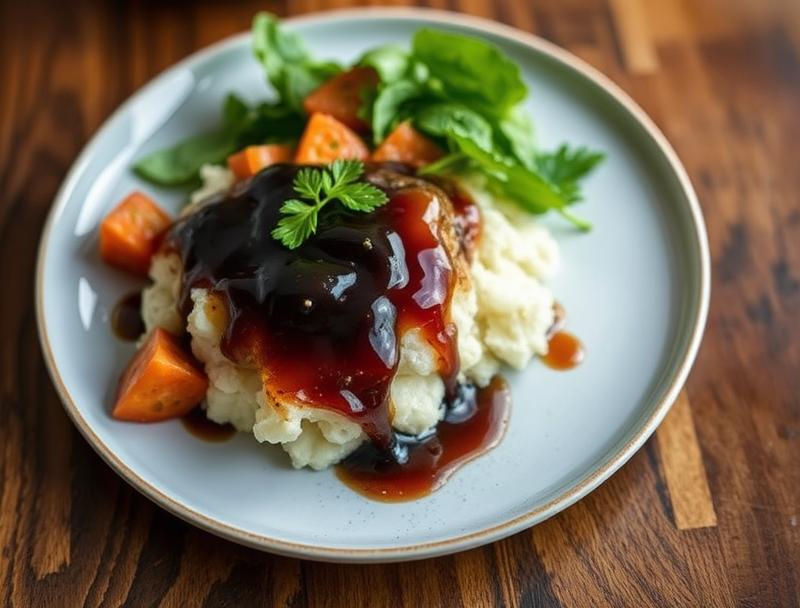Balsamic Glaze Recipe
Introduction
Imagine a rich, deep flavor that elevates any dish to new heights, made from ingredients you likely have in your pantry. Welcome to the world of balsamic glaze, a reduction of balsamic vinegar that is as versatile as it is delicious. With its origins in Modena, Italy, balsamic glaze has become a staple in many kitchens around the globe, and for good reason. It’s incredibly easy to make, requiring just a few ingredients and some patience, but the payoff is well worth the wait. Whether you’re looking to add a drizzle of elegance to your salads, a burst of flavor to your meats, or a tangy zip to your cheeses, balsamic glaze is the perfect addition. In this article, we’ll dive into the simplicity and creativity of making your own balsamic glaze at home, using everyday ingredients that will make your taste buds dance.
Why This Works
- The balance of flavors in balsamic glaze, with its sweet and sour notes, makes it a versatile condiment that can complement a wide range of dishes without overpowering them.
- The ease of preparation is a significant advantage. All you need is balsamic vinegar and some time for it to reduce. No fancy equipment or hard-to-find ingredients are required.
- Despite the simplicity of the recipe, the results are impressive. The thick, syrupy glaze adds a professional touch to any dish, making it perfect for special occasions or everyday meals alike.
Ingredients
- 1 cup of high-quality balsamic vinegar
- 1/2 cup of water (optional, for a lighter glaze)
- 1 tablespoon of honey or sugar (optional, for a sweeter glaze)
Instructions
- Step 1: Begin by pouring the balsamic vinegar into a small saucepan. If you’re using water or honey/sugar to adjust the consistency or sweetness, add them now.
- Step 2: Place the saucepan over medium heat and bring the vinegar mixture to a boil. Once boiling, reduce the heat to low or medium-low and let it simmer.
- Step 3: Allow the mixture to reduce, stirring occasionally, until it reaches your desired consistency. This can take anywhere from 20 to 40 minutes, depending on how thick you like your glaze. Remember, the glaze will thicken a bit more as it cools.
- Step 4: Remove the glaze from the heat and let it cool to room temperature. Transfer it to an airtight container, such as a glass jar with a tight-fitting lid, and store it in the refrigerator for up to 6 months.
Handy Tips
- Always use a high-quality balsamic vinegar for the best flavor. While it might be more expensive, the difference in taste is noticeable.
- If you find your glaze too thick, you can thin it out with a bit of water. If it’s too thin, simply return it to the heat and reduce it further.
- Experiment with flavors by adding a cinnamon stick, a few cloves, or a sprig of fresh rosemary to the vinegar as it reduces. This can add a unique twist to your glaze.
Heat Control
Maintaining the right heat is crucial. You want the vinegar to simmer gently; if it’s too hot, it can burn or become too thick too quickly. Ideally, keep the heat at a level where you see small bubbles rising to the surface, but it’s not boiling vigorously. This gentle simmer is key to developing the deep, rich flavor of the glaze.
Crunch Factor
Balsamic glaze is all about smooth, velvety texture. To achieve this, make sure to stir the glaze occasionally as it reduces to prevent scorching, which can introduce unwanted texture. The glaze is ready when it coats the back of a spoon thickly, indicating it has reached the perfect consistency.
Pro Kitchen Tricks
- For a quicker reduction, you can use a wider saucepan, as this increases the surface area of the vinegar exposed to heat. However, be careful not to burn the glaze.
- Experimenting with different types of vinegar, such as apple cider vinegar or wine vinegar, can create unique flavor profiles for your glaze.
- Consider making a large batch of balsamic glaze and dividing it into smaller jars to give as gifts or to store for future use.
Storage Tips
- Store your balsamic glaze in an airtight container in the refrigerator. It will keep for several months.
- If you notice your glaze starting to crystallize, don’t worry; this is a natural process. Simply warm the glaze gently before use to dissolve the crystals.
- For gifting, consider decorative glass jars with tight-fitting lids. You can add a ribbon or label for a personal touch.
Gift Packaging Ideas
Balsamic glaze makes a wonderful gift for foodies and home cooks. Package it in decorative jars, and consider pairing it with a basket of artisanal cheeses, crackers, and fruits for a complete gourmet experience. Adding a few recipe cards with ideas for using the glaze can make the gift even more special and inspiring.
Flavor Variations
- Try adding different spices or herbs to the glaze as it reduces, such as cinnamon, cloves, or thyme, to create unique flavor profiles.
- Experiment with various types of sugar or honey to find the sweetness level you prefer.
- For a smoky flavor, add a bit of liquid smoke to the glaze during the reduction process.
Troubleshooting
- If your glaze becomes too thick, it can be thinned with a bit of water. Conversely, if it’s too thin, return it to the heat to reduce further.
- Watch for scorching, which can give the glaze a bitter taste. Stir regularly and adjust the heat as needed.
- If you notice mold or an off smell, it’s best to discard the glaze and start fresh.
FAQs
- Can I freeze balsamic glaze? Yes, you can freeze balsamic glaze. Transfer it to an airtight container or freezer bag and store it in the freezer for up to a year. Thaw frozen glaze in the refrigerator or at room temperature when you’re ready to use it.
- Is balsamic glaze gluten-free? Traditional balsamic glaze made from balsamic vinegar is gluten-free, but always check the ingredients of your specific vinegar to ensure it hasn’t been processed in a facility that also handles gluten.
- Can I double or triple the recipe? Absolutely, you can scale up the recipe to make more glaze. Just remember that larger quantities may take longer to reduce.
Conclusion
Making your own balsamic glaze at home is a simple yet rewarding process that can elevate your cooking and add a professional touch to your dishes. With its versatility, rich flavor, and ease of preparation, it’s no wonder balsamic glaze has become a staple in kitchens around the world. Don’t be afraid to experiment with different flavors and ingredients to make your glaze truly unique. Whether you’re a seasoned chef or just starting out, balsamic glaze is a condiment that will inspire your creativity and delight your palate. So go ahead, give it a try, and discover the magic of balsamic glaze for yourself.

